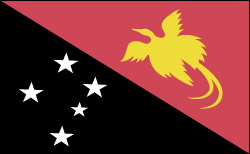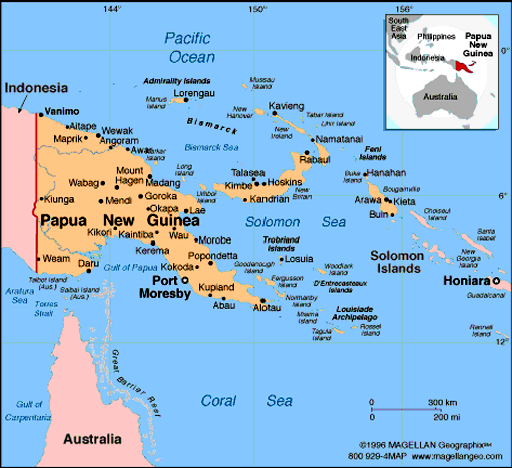PAPUA NEW GUINEA

Geography: Papua New Guinea occupies the eastern half of the island of New Guinea, just north of Australia, and many outlying islands. The Indonesian province of West Papua (Irian Jaya) is to the west. To the north and east are the islands of Manus, New Britain, New Ireland, and Bougainville, all part of Papua New Guinea. About one-tenth larger than California, its mountainous interior has only recently been explored. Two major rivers, the Sepik and the Fly, are navigable for shallow-draft vessels.
Government: Constitutional monarchy with parliamentary democracy.
History: The first inhabitants of the island New Guinea were Papuan, Melanesian, and Negrito tribes, who altogether spoke more than 700 distinct languages. The eastern half of New Guinea was first explored by Spanish and Portuguese explorers in the 16th century. In 1828, the Dutch formally took possession of the western half of the island (now the province of West Papua [Irian Jaya], Indonesia). In 1885, Germany formally annexed the northern coast and Britain took similar action in the south. In 1906, Britain transferred its rights to British New Guinea to a newly independent Australia, and the name of the territory was changed to the Territory of Papua. Australian troops invaded German New Guinea (called Kaiser-Wilhelmsland) in World War I and gained control of the territory under a League of Nations mandate. New Guinea and some of Papua were invaded by Japanese forces in 1942. After being liberated by the Australians in 1945, it became a United Nations trusteeship, administered by Australia. The territories were combined and called the Territory of Papua and New Guinea (PNG).
Australia granted limited home rule in 1951. Autonomy in internal affairs came nine years later, and in Sept. 1975, Papua New Guinea achieved complete independence from Britain.
A violent nine-year secessionist movement took place on the island of Bougainville. In 1989, guerrillas of the Bougainville Revolutionary Army (BRA) shut down the island's Australian-owned copper mine, a major source of revenue for the country. The rebels believed that Bougainville deserved a greater share of the earnings for its copper. In 1990, the BRA declared Bougainville's independence, whereupon the government blockaded the island until Jan. 1991, when a peace treaty was signed.
On July 17, 1998, an earthquake-triggered tsunami off the northern coast of PNG killed at least 1,500 people and left thousands more injured and homeless.
Many analysts say Papua New Guinea is in danger of political and economic collapse. The country's political system is unstable, the crime rate has soared, corruption is rampant, and essential services including health care and education continue to decline. According to the World Bank, 70% of the country lives in poverty. In 2006, Australia announced that it was gravely concerned about the country and had peacekeeping forces at the ready.
Sir Michael Somare was elected to a second consecutive term as prime minister in August 2007, defeating Sir Julius Chan.
Governor-General Sir Paulias Matane was reelected in June 2010, but was removed from office after the Supreme Court ruled that the election was unconstitutional. Jeffery Nape became acting governor-general on Dec. 13, but without explanation, Michael Ogio took over as acting governor-general on Dec. 20.
In April 2011, a tribunal convicted Prime Minister Sir Michael Somare of misconduct and suspended him for two weeks. Citing ill health, he extended his absence and Sam Abal became acting prime minister. Somare officially resigned in June.
In August, the parliamentary-designated vacancy in the prime minister's office and the election of Peter O'Neill were ruled illegal by the Supreme Court, who then ordered the reinstatement of Sir Michael Somare as prime minister. Mr. O'Neill refused to acknowledge the order and remained in office. A rebel group led by Colonel Sasa mutinied, but failed in its attempt to restore Somare's prime ministership. Parliamentary elections take place in June 2012.
Government: Constitutional monarchy with parliamentary democracy.
History: The first inhabitants of the island New Guinea were Papuan, Melanesian, and Negrito tribes, who altogether spoke more than 700 distinct languages. The eastern half of New Guinea was first explored by Spanish and Portuguese explorers in the 16th century. In 1828, the Dutch formally took possession of the western half of the island (now the province of West Papua [Irian Jaya], Indonesia). In 1885, Germany formally annexed the northern coast and Britain took similar action in the south. In 1906, Britain transferred its rights to British New Guinea to a newly independent Australia, and the name of the territory was changed to the Territory of Papua. Australian troops invaded German New Guinea (called Kaiser-Wilhelmsland) in World War I and gained control of the territory under a League of Nations mandate. New Guinea and some of Papua were invaded by Japanese forces in 1942. After being liberated by the Australians in 1945, it became a United Nations trusteeship, administered by Australia. The territories were combined and called the Territory of Papua and New Guinea (PNG).
Australia granted limited home rule in 1951. Autonomy in internal affairs came nine years later, and in Sept. 1975, Papua New Guinea achieved complete independence from Britain.
A violent nine-year secessionist movement took place on the island of Bougainville. In 1989, guerrillas of the Bougainville Revolutionary Army (BRA) shut down the island's Australian-owned copper mine, a major source of revenue for the country. The rebels believed that Bougainville deserved a greater share of the earnings for its copper. In 1990, the BRA declared Bougainville's independence, whereupon the government blockaded the island until Jan. 1991, when a peace treaty was signed.
On July 17, 1998, an earthquake-triggered tsunami off the northern coast of PNG killed at least 1,500 people and left thousands more injured and homeless.
Many analysts say Papua New Guinea is in danger of political and economic collapse. The country's political system is unstable, the crime rate has soared, corruption is rampant, and essential services including health care and education continue to decline. According to the World Bank, 70% of the country lives in poverty. In 2006, Australia announced that it was gravely concerned about the country and had peacekeeping forces at the ready.
Sir Michael Somare was elected to a second consecutive term as prime minister in August 2007, defeating Sir Julius Chan.
Governor-General Sir Paulias Matane was reelected in June 2010, but was removed from office after the Supreme Court ruled that the election was unconstitutional. Jeffery Nape became acting governor-general on Dec. 13, but without explanation, Michael Ogio took over as acting governor-general on Dec. 20.
In April 2011, a tribunal convicted Prime Minister Sir Michael Somare of misconduct and suspended him for two weeks. Citing ill health, he extended his absence and Sam Abal became acting prime minister. Somare officially resigned in June.
In August, the parliamentary-designated vacancy in the prime minister's office and the election of Peter O'Neill were ruled illegal by the Supreme Court, who then ordered the reinstatement of Sir Michael Somare as prime minister. Mr. O'Neill refused to acknowledge the order and remained in office. A rebel group led by Colonel Sasa mutinied, but failed in its attempt to restore Somare's prime ministership. Parliamentary elections take place in June 2012.

Map of Papua
New Guinea
Sovereign: Queen Elizabeth II
(1952)
Governor-General: Michael Ogio
(2011)
Prime Minister: Peter Paire O'Neill (2012)
Land area: 174,849 sq mi (452,860 sq km);
total area: 178,703 sq mi (462,840 sq km)
Population (2014 est.): 6,552,730
(growth rate: 1.84%); birth rate: 24.89/1000; infant mortality rate:
39.67/1000; life expectancy: 66.85
Capital and largest city (2011 est.):
Port Moresby, 343,000
Monetary unit: Kina
Languages:
Tok Pisin (Melanesian Pidgin, the lingua
franca), Hiri Motu (in Papua region) less than 2%, English 1%–2%; 836 indigenous
languages
Ethnicity/race:
Melanesian, Papuan, Negrito, Micronesian,
Polynesian
Religions:
Roman Catholic 27%, Protestant 69.4% (Evangelical Lutheran
19.5%, United Church 11.5%, Seventh-Day Adventist 10%, Pentecostal 8.6%,
Evangelical Alliance 5.2%, Anglican 3.2%, Baptist 2.5%, other
Protestant 8.9%), Baha'i 0.3%, indigenous beliefs and other 3.3% (2000
census)
Literacy rate: 62.4% (2011 est.)
Economic summary: GDP/PPP (2013
est.): $19.96 billion; per capita $2,900. Real growth rate:
5.4%. Inflation: 3.8%. Unemployment: 1.9% (2008). Arable land: 0.65%. Agriculture:
coffee, cocoa, copra, palm kernels, tea, sugar, rubber, sweet
potatoes, fruit, vegetables, vanilla, shellfish, poultry, pork.
Labor force: 4.077 million (2013 est.); agriculture 27.6%,
industry 39.1%, services 33.3%. Industries: copra crushing, palm
oil processing, plywood production, wood-chip production; mining of
gold, silver, and copper; crude oil production, petroleum refining;
construction, tourism. Natural resources: gold, copper,
silver, natural gas, timber, oil, fisheries. Exports: $5.392
billion (2013 est.): oil, gold, copper ore, logs, palm oil,
coffee, cocoa, crayfish, prawns. Imports: $4.587 billion
(2013 est.): machinery and transport equipment, manufactured
goods, food, fuels, chemicals. Major trading partners:
Australia, Japan, China, Germany, Singapore, U.S., Malaysia (2012).
Member of Commonwealth of Nations
Communications: Telephones: main lines
in use: 139,000 (2012); mobile cellular: 2.709 million (2012). Broadcast media:
2 television stations, 1 commercial station operating since the late
1980s and 1 state-run station launched in 2008; satellite and cable TV
services are available; state-run National Broadcasting Corporation
operates 3 radio networks with multiple repeaters and about 20
provincial stations; several commercial radio stations with multiple
transmission points as well as several community stations; transmissions
of several international broadcasters are accessible (2009) Internet Service
Providers (ISPs): 5,006 (2012). Internet users: 125,000
(2009).
Transportation: Railways: 0 km.
Highways: total: 9,349 km; paved: 3,000 km; unpaved: 6,349
km (2011 est.). Waterways: 11,000 km (2011). Ports and
terminals: Kimbe, Lae, Madang, Rabaul, Wewak.
Airports: 561 (2013).
International disputes:
Papua New Guinea relies on assistance from Australia to keep out
illegal cross-border activities from primarily Indonesia, including
goods smuggling, illegal narcotics trafficking, and squatters and
secessionists.
-------------------- o --------------------
No comments:
Post a Comment